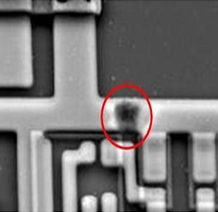Clone IC AT90S2313 Firmware
Clone IC AT90S2313 Firmware and then duplicate the program and data to blank MCU AT90S2313 memory, break Microprocessor AT90S2313 tamper resistance system;

Clone IC AT90S2313 Firmware and then duplicate the program and data to blank MCU AT90S2313 memory, break Microprocessor AT90S2313 tamper resistance system
The AT90S2313 provides the following features: 2K bytes of In-System Programmable Flash, 128 bytes EEPROM, 128 bytes SRAM, 15 general purpose I/O lines, 32 general purpose working registers, flexible timer/counters with compare modes, internal and external interrupts, a programmable serial UART, programmable Watchdog Timer with internal oscillator, an SPI serial port for Flash Memory downloading and two software selectable power saving modes.
The Idle Mode stops the CPU while allowing the SRAM, timer/counters, SPI port and interrupt system to continue functioning. The power down mode saves the register contents but freezes the oscillator, disabling all other chip functions until the next interrupt or hardware reset when Chip PIC10F222 memory unlocking.
The device is manufactured using Atmel’s high density non-volatile memory technology. The on-chip In-System Programmable Flash allows the program memory to be reprogrammed in-system through an SPI serial interface or by a conventional nonvolatile memory programmer.
By combining an enhanced RISC 8-bit CPU with In-System Programmable Flash on a monolithic chip, the Atmel AT90S2313 is a powerful microcontroller that provides a highly flexible and cost effective solution to many embedded control applications before MCU dsPIC30F2020 program cracking.
The AT90S2313 AVR is supported with a full suite of program and system development tools including: C compilers, macro assemblers, program debugger/simulators, in-circuit emulators, and evaluation kits. Port B is an 8-bit bi-directional I/O port. Port pins can provide internal pull-up resistors (selected for each bit).
PB0 and PB1 also serve as the positive input (AIN0) and the negative input (AIN1), respectively, of the on-chip analog comparator. The Port B output buffers can sink 20mA and can drive LED displays directly. When pins PB0 to PB7 are used as inputs and are externally pulled low, they will source current if the internal pull-up resistors are activated when chip dsPIC30F2010 firmware cracking.
The fast-access register file concept contains 32 x 8-bit general purpose working registers with a single clock cycle access time. This means that during one single clock cycle, one ALU (Arithmetic Logic Unit) operation is executed. Two operands are output from the register file, the operation is executed, and the result is stored back in the register file – in one clock cycle.
Six of the 32 registers can be used as three 16-bits indirect address register pointers for Data Space addressing – enabling efficient address calculations. One of the three address pointers is also used as the address pointer for the constant table look up function. These added function registers are the 16-bits X-register, Y-register and Z-register.
The ALU supports arithmetic and logic functions between registers or between a constant and a register. Single register operations are also executed in the ALU. Figure 4 shows the AT90S2313 AVR Enhanced RISC microcontroller architecture.
In addition to the register operation, the conventional memory addressing modes can be used on the register file as well. This is enabled by the fact that the register file is assigned the 32 lowermost Data Space addresses ($00 – $1F), allowing them to be accessed as though they were ordinary memory locations.
The I/O memory space contains 64 addresses for CPU peripheral functions as Control Registers, Timer/Counters, A/D-converters, and other I/O functions. The I/O memory can be accessed directly, or as the Data Space locations following those of the register file, $20 – $5F.
The AVR has Harvard architecture – with separate memories and buses for program and data. The program memory is accessed with a two stage pipeline. While one instruction is being executed, the next instruction is pre-fetched from the program memory. This concept enables instructions to be executed in every clock cycle. The program memory is In-system Programmable Flash memory.
Tags: clone ic encrypted archive,clone ic encrypted code,clone ic encrypted content,clone ic encrypted data,clone ic encrypted eeprom,clone ic encrypted file,clone ic encrypted firmware,clone ic encrypted information,clone ic encrypted memory,clone ic encrypted program

